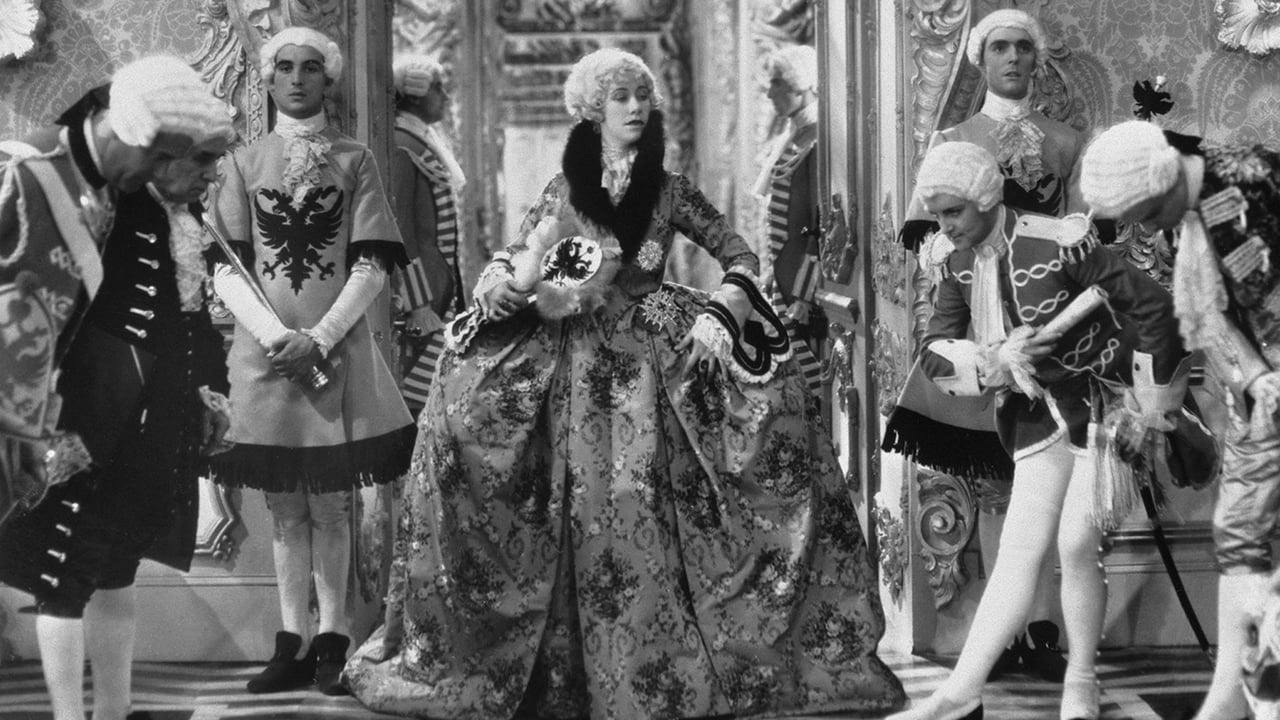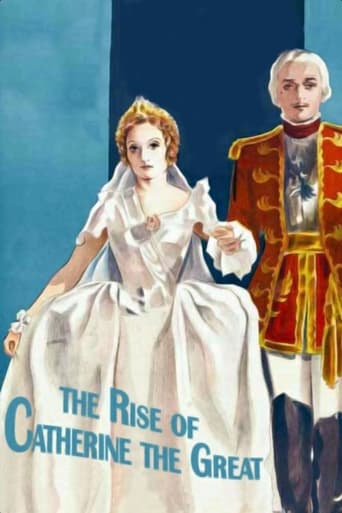



Pretty Good
Charming and brutal
It is neither dumb nor smart enough to be fun, and spends way too much time with its boring human characters.
View MoreThrough painfully honest and emotional moments, the movie becomes irresistibly relatable
View MoreLike "Rembrandt" which I recently reviewed on this board "The Rise of Catherine the Great" is an ostensibly British historical film from the thirties which might also be regarded as a multi-national co-production. It was based on the play by two Hungarian writers (Lajos Bíró and Melchior Lengyel) about a German-born Russian Empress. It had two co-producers, one Hungarian (Alexander Korda) and one Italian (Ludovico Toeplitz), an Austrian director (Paul Czinner) and an American-born leading man (Douglas Fairbanks junior). Its leading lady, Elisabeth Bergner, is difficult to categorise in terms of ethnicity. She was born to a German-speaking Jewish family in what was at the time of her birth part of the Austro-Hungarian Empire, at the time this film was made part of Poland and today is part of the Ukraine. Rather than determine whether she should be described as German, Austrian, Hungarian, Polish or Ukrainian, her Wikipedia entry evades the issue by calling her a "European actress".In 1745 Princess Sophie Auguste Frederika of Anhalt-Zerbst arrived in Russia to marry the Grand Duke Peter, heir to the Russian throne. Although Peter had a Russian mother, he too was from a German princely house, that of Holstein-Gottorp, and could speak little Russian. (By rights the name of Russia's ruling dynasty should, from 1762 onwards, have been the House of Holstein-Gottorp, but for reasons of both nationalism and continuity Peter's descendants continued to use the more authentically Russian surname Romanov). Upon arrival Sophie's name was arbitrarily changed to Yekaterina, generally rendered in English as Catherine, even though "Sofiya" would have been a perfectly acceptable Russification of her German name. Her marriage to the mentally unstable Peter was not a happy one, but they remained together until after he had ascended the throne in 1762. (Divorce would presumably have been unthinkable). As Tsar Peter proved a disaster, and within a few months he was removed from power by a military coup, dying in mysterious circumstances shortly afterwards, following which the coup plotters invited Catherine to become Empress in her own right.As its title suggests, the film only deals with Catherine's rise to power and not with her subsequent reign. One or two details have been changed for dramatic purposes; in reality Catherine and Peter's marriage lasted for seventeen years, but in the film this period is greatly telescoped and no mention is made of their children. (Their son Paul eventually became Tsar after Catherine's death, even though he was nearly as mad as his father). No mention is also made of the historical Catherine's notorious sexual promiscuity, but in 1934 movie heroines were required to be impeccably virtuous, and Catherine is very much the heroine here.Bergner is not very good in the leading role, partly because she did not speak English very well but mainly because she is insufficiently imperious and commanding to make us think that this is a woman capable of not only ruling a mighty empire in her own right but also ruling it so well as to acquire the title "The Great". One cannot envisage Bergman's "Little Catherine" ever amounting to more than, at most, a puppet in the hands of the aristocrats and military officers who carried out the coup d'état.Fairbanks, however, is good as Peter, a difficult role to play because in this production Peter, although suffering from mental illness, is not altogether unsympathetic. At times he is capable of showing love towards Catherine, who for a time returns his love until he begins an affair with another woman. When he dies in the coup his wife is devastated, which is probably more than one could say for the real Catherine. Flora Robson is also good as Empress Elizabeth, Peter's aunt and Catherine's autocratic if capable predecessor.The mid-eighteenth century was a period when clothes and furnishings favoured by the wealthy classes of Europe were particularly fanciful and elaborate, and this is reflected in the lavish sets and costumes on view here. (By this period the Russian nobility had largely adopted Western fashions; had the story been set a hundred years earlier the clothes of the Boyars and their wives would have been very different to those worn by their English or French counterparts). It is therefore a pity that the film was made in black-and-white, but in 1934 colour film was an expensive luxury, rarely used in Britain. "The Rise of Catherine the Great" is a fairly decent historical yarn, but I felt it could have been better with another actress in the leading role. 6/10 A goof. The film begins and ends with a rousing rendition of the Russian Imperial Anthem, "Tsarya, Bozhe, Khrani", but this hymn was not written until 1833, long after the date when the film is set.
View MoreThe dynasties of Europe are usually recalled only when they rule major nations for a long time: Plantagenets, Tudors, Stuarts, Hanovarians, Windsors in England; Valois and Bourbon in French; Hapsburg of Austria; Hohenzollern of Prussia and Germany; and Romanov of Russia. The smaller dynasties pop up if they last long enough too: Saxe - Coburg in Belgium (and Bulgaria), Wittelsbach in Bavaria, Holsteins and Bernadottes in Sweden. Occasionally transplanted dynasties are recalled: Hapsburg and Bourbon in Spain. Less recalled is if the spouse of a royal heir was from a really obscure family. But in the long run the need for new "blood" to continue a dynasty would lead to minor nobility producing wives or husbands for the major dynasties. It was rare for any of the these minor figures to become well known. But Princess Sophie of Anhalt-Zerbst did just that. In fact she was to become a great figure in her own time and in modern history. For Sophie became the Tsarina Catherine the Great of Russia.Two films that came out in 1934 dealt with Catherine's rise to power. One was THE SCARLET EMPRESS by Joseph Von Sternberg (starring Marlene Dietrich, John Lodge, and Sam Jaffe) and the other was THE RISE OF CATHERINE THE GREAT. As pointed out in another review, the two movies each have aspects of the story missed by the other. Elizabeth Bergner manages to show more of the naiveté of the young Princess brought to Russia to marry the Grand Duke Pyotr (who became Peter III). Peter (Douglas Fairbanks Jr.) was the sole male descendant of the Romanovs (except for a cousin who had been dethroned in 1741 by the reigning Empress Elizabeth (Flora Robson) and was held in a prison*). Tsarina Elizabeth was determined to have Peter marry and have an heir. She chose Sophie because of dynastic claims to Swedish and Baltic territories of the Romanov Family dealing with their Holstein blood connections - connections that Anhalt-Zerbst shared. Both movies show how Elizabeth and Catherine (her name was changed to Catherine when she married Peter, as her Lutheran religion was changed to Greek Orthodoxy) treat each other with wariness, but gradually get to see each other as an ally. This is particularly true because Peter was mentally ill. However, while this is shown in THE SCARLET EMPRESS, it is not true about THE RISE. Fairbanks is shown to be mentally ill, but a type of affection rises between him and Catherine every now and then - which is dashed by his paranoia and suspicions.The performance of Bergner is quite charming (as normal) in this film, and one gets a feeling of sadness that is not historically accurate. Here as history marches on, Catherine regretfully joins in the overthrow of her husband, and watches helplessly while he is taken away to his doom. The actual situation in the overthrow of Peter was closer to the cynical contempt shown by Marlene Dietrich towards her mad husband.Flora Robson portrays Tsarina Elizabeth as a tired, dying woman, desperate to try to save the dynasty and her nation but aware of the rotten material she has to work with. It's as good a performance as the two leads.I might add that you should note two brief supporting performances for a historical reason. Gerald Du Maurier (Daphne's father) was a leading stage star in England from the 1900s to 1930s. Irene Vanbrugh was a female star of the 1890s - 1920s (she was in the original THE IMPORTANCE OF BEING EARNEST). Both play roles in this version - Irene Vanbrugh as Bergner's mother. It is very rare to see either of them on film.*The cousin, Ivan VI, was imprisoned for life - and gradually lost his reason. The guards were told to kill him if there was ever an attempt to rescue the Tsar. When Peter III was overthrown, an adventurer attempted to rescue Ivan and restore him to his throne. Ivan was slain by his guards before the adventurer could reach him.
View MoreAlthough Marlene Dietrich was a far more glamorous Catherine the Great, closer to the real one was definitely Elizabeth Bergner in this British production from Alexander Korda. The former Princess Sophia of Anhalt-Zerbst, one of many small pieces of turf in Germany before that country became a country instead of a geographical expression, pulled off something unique in history. She came as a promised bride to the tsarevitch who in this case was Peter, nephew of the Empress Elizabeth of Russia. Through her own will and genius for intrigue, this Queen Consort, without a drop of royal blood of Russia in her, got to rule Russia and well for over 30 years after deposing her husband. Woman must have done something right.The film here like the one in Hollywood ends with the deposition and death of the Czar and Catherine taking over. We don't see the regal, confident, and promiscuous empress Catherine was to become. We see her as a shy and overwhelmed German Princess who grows in her role as her husband won't in his. Catherine grows in her character as Elizabeth Bergner does in this part.Sam Jaffe as Peter is far closer to the mark of the real character of that unfortunate soul than Douglas Fairbanks, Jr. is in this film. Yet Fairbanks gives an extraordinary performance, far from the swashbuckling parts that his father patented on the silent screen. In fact both the Fairbanks were in the UK at the same time. Fairbanks senior gave his farewell screen performance in the Private Life of Don Juan and his son did about seven films for four years of which this is probably his best effort.The pleasure loving Empress Elizabeth as done by Flora Robson is light years different from Queen Elizabeth in Fire Over England and The Sea Hawk that Robson did later, but still very nicely done.Alexander Korda perfectly captured the mood and feel of old Romanov Russia as taken over by a usurper, a popular one, but still a usurper.
View MoreThe alternative title "The Rise of Catherine the Great" is much more accurate since the picture ends with her getting the throne.The costumes and sets are Grade A Hollywood (compliment).Flora Robson (Empress Elisabeth) has the best lines and delivers them impressively. Elisabeth Bergner (Catherine) does well in her scenes with the Empress. Douglas Fairbanks Jr. (Grand Duke Peter) seems out of his depth.
View More